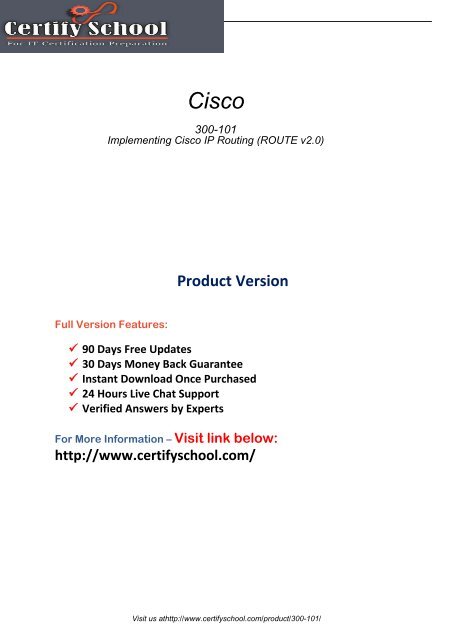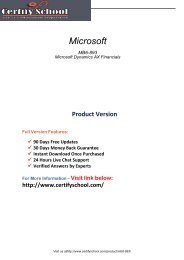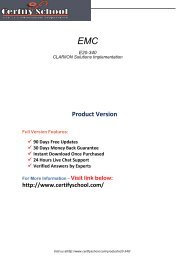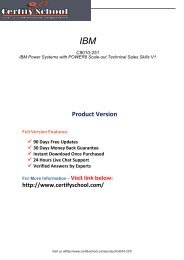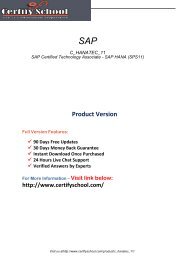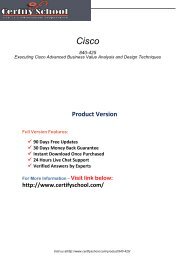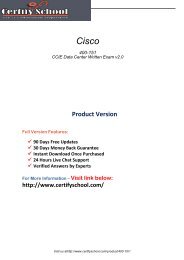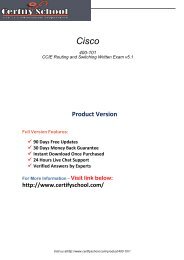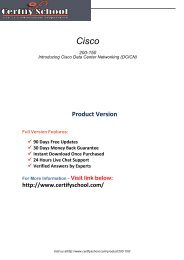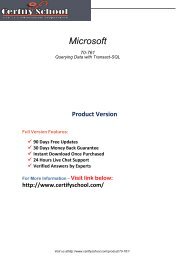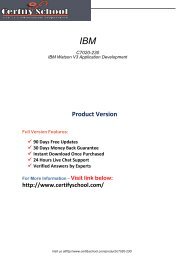300-101 Real Exam Material
Provided study material for 300-101 Certification Test is created and checked by authorized persons of relevant industry. You can use this PDF training kits to pass your exam. For more info please visit here: http://www.certifyschool.com/product/300-101/
Provided study material for 300-101 Certification Test is created and checked by authorized persons of relevant industry. You can use this PDF training kits to pass your exam. For more info please visit here: http://www.certifyschool.com/product/300-101/
You also want an ePaper? Increase the reach of your titles
YUMPU automatically turns print PDFs into web optimized ePapers that Google loves.
Cisco<br />
<strong>300</strong>-<strong>101</strong><br />
Implementing Cisco IP Routing (ROUTE v2.0)<br />
Product Version<br />
Full Version Features:<br />
90 Days Free Updates<br />
30 Days Money Back Guarantee<br />
Instant Download Once Purchased<br />
24 Hours Live Chat Support<br />
Verified Answers by Experts<br />
For More Information – Visit link below:<br />
http://www.certifyschool.com/<br />
Visit us athttp://www.certifyschool.com/product/<strong>300</strong>-<strong>101</strong>/
Question: 1<br />
Refer to the exhibit.<br />
Based on this FIB table, which statement is correct?<br />
A. There is no default gateway.<br />
B. The IP address of the router on FastEthernet is 209.168.201.1.<br />
C. The gateway of last resort is 192.168.201.1.<br />
D. The router will listen for all multicast traffic.<br />
Answer: C<br />
Question: 2<br />
Refer to the exhibit.<br />
A network administrator checks this adjacency table on a router. What is a possible cause for the<br />
incomplete marking?<br />
A. incomplete ARP information<br />
B. incorrect ACL<br />
C. dynamic routing protocol failure<br />
D. serial link congestion<br />
Answer: A<br />
Visit us athttp://www.certifyschool.com/product/<strong>300</strong>-<strong>101</strong>/
Question: 3<br />
A network engineer notices that transmission rates of senders of TCP traffic sharply increase and<br />
decrease simultaneously during periods of congestion. Which condition causes this?<br />
A. global synchronization<br />
B. tail drop<br />
C. random early detection<br />
D. queue management algorithm<br />
Question: 4<br />
Answer: A<br />
Which three problems result from application mixing of UDP and TCP streams within a network with no<br />
QoS? (Choose three.)<br />
A. starvation<br />
B. jitter<br />
C. latency<br />
D. windowing<br />
E. lower throughput<br />
Question: 5<br />
Answer: A, C, E<br />
Which method allows IPv4 and IPv6 to work together without requiring both to be used for a single<br />
connection during the migration process?<br />
A. dual-stack method<br />
B. 6to4 tunneling<br />
C. GRE tunneling<br />
D. NAT-PT<br />
Question: 6<br />
Answer: A<br />
Which statement about the use of tunneling to migrate to IPv6 is true?<br />
Visit us athttp://www.certifyschool.com/product/<strong>300</strong>-<strong>101</strong>/
A. Tunneling is less secure than dual stack or translation.<br />
B. Tunneling is more difficult to configure than dual stack or translation.<br />
C. Tunneling does not enable users of the new protocol to communicate with users of the old protocol<br />
without dual-stack hosts.<br />
D. Tunneling destinations are manually determined by the IPv4 address in the low-order 32 bits of IPv4-<br />
compatible IPv6 addresses.<br />
Question: 7<br />
Answer: C<br />
A network administrator executes the command clear ip route. Which two tables does this command<br />
clear and rebuild? (Choose two.)<br />
A. IP routing<br />
B. FIB<br />
C. ARP cache<br />
D. MAC address table<br />
E. Cisco Express Forwarding table<br />
F. topology table<br />
Question: 8<br />
Answer: A, B<br />
Which switching method is used when entries are present in the output of the command show ip cache?<br />
A. fast switching<br />
B. process switching<br />
C. Cisco Express Forwarding switching<br />
D. cut-through packet switching<br />
Question: 9<br />
Answer: A<br />
Which two actions must you perform to enable and use window scaling on a router? (Choose two.)<br />
A. Execute the command ip tcp window-size 65536.<br />
B. Set window scaling to be used on the remote host.<br />
C. Execute the command ip tcp queuemax.<br />
Visit us athttp://www.certifyschool.com/product/<strong>300</strong>-<strong>101</strong>/
D. Set TCP options to "enabled" on the remote host.<br />
E. Execute the command ip tcp adjust-mss.<br />
Answer: A, B<br />
Question: 10<br />
Which three TCP enhancements can be used with TCP selective acknowledgments? (Choose three.)<br />
A. header compression<br />
B. explicit congestion notification<br />
C. keepalive<br />
D. time stamps<br />
E. TCP path discovery<br />
F. MTU window<br />
Question: 11<br />
Answer: B, C, D<br />
A network administrator uses IP SLA to measure UDP performance and notices that packets on one<br />
router have a higher one-way delay compared to the opposite direction. Which UDP characteristic does<br />
this scenario describe?<br />
A. latency<br />
B. starvation<br />
C. connectionless communication<br />
D. nonsequencing unordered packets<br />
E. jitter<br />
Question: 12<br />
Answer: A<br />
Under which condition does UDP dominance occur?<br />
A. when TCP traffic is in the same class as UDP<br />
B. when UDP flows are assigned a lower priority queue<br />
C. when WRED is enabled<br />
D. when ACLs are in place to block TCP traffic<br />
Visit us athttp://www.certifyschool.com/product/<strong>300</strong>-<strong>101</strong>/
Answer: A<br />
Question: 13<br />
Prior to enabling PPPoE in a virtual private dialup network group, which task must be completed?<br />
A. Disable CDP on the interface.<br />
B. Execute the vpdn enable command.<br />
C. Execute the no switchport command.<br />
D. Enable QoS FIFO for PPPoE support.<br />
Question: 14<br />
Answer: B<br />
A network engineer has been asked to ensure that the PPPoE connection is established and<br />
authenticated using an encrypted password. Which technology, in combination with PPPoE, can be used<br />
for authentication in this manner?<br />
A. PAP<br />
B. dot1x<br />
C. IPsec<br />
D. CHAP<br />
E. ESP<br />
Answer: D<br />
Question: 15<br />
A corporate policy requires PPPoE to be enabled and to maintain a connection with the ISP, even if no<br />
interesting traffic exists. Which feature can be used to accomplish this task?<br />
A. TCP Adjust<br />
B. Dialer Persistent<br />
C. PPPoE Groups<br />
D. half-bridging<br />
E. Peer Neighbor Route<br />
Answer: B<br />
Visit us athttp://www.certifyschool.com/product/<strong>300</strong>-<strong>101</strong>/
Question: 16<br />
SIMULATION<br />
Route.com is a small IT corporation that is attempting to implement the network shown in the exhibit.<br />
Currently the implementation is partially completed. OSPF has been configured on routers Chicago and<br />
NewYork. The SO/O interface on Chicago and the SO/1 interface on NewYork are in Area 0. The<br />
loopbackO interface on NewYork is in Area 1. However, they cannot ping from the serial interface of the<br />
Seattle router to the loopback interface of the NewYork router. You have been asked to complete the<br />
implementation to allow this ping.<br />
ROUTE.com's corporate implementation guidelines require:<br />
• The OSPF process ID for all routers must be 10.<br />
• The routing protocol for each interface must be enabled under the routing process.<br />
• The routing protocol must be enabled for each interface using the most specific wildcard mask<br />
possible.<br />
• The serial link between Seattle and Chicago must be in OSPF area 21.<br />
• OSPF area 21 must not receive any inter-area or external routes.<br />
Network Information<br />
Seattle<br />
S0/0 192.168.16.5/30 - Link between Seattle and Chicago<br />
Secret Password: cisco<br />
Chicago<br />
S0/0 192.168.54.9/30 - Link between Chicago and NewYork<br />
S0/1 192.168.16.6/30 - Link between Seattle and Chicago Secre<br />
Password: cisco<br />
NewYork<br />
S0/1 192.168.54.10/30 - Link between Chicago and NewYork<br />
Loopback0 172.16.189.189<br />
Secret Password: cisco<br />
Visit us athttp://www.certifyschool.com/product/<strong>300</strong>-<strong>101</strong>/
Visit us athttp://www.certifyschool.com/product/<strong>300</strong>-<strong>101</strong>/
Answer:<br />
Here is the solution below:<br />
Explanation:<br />
Note: In actual exam, the IP addressing, OSPF areas and process ID, and router hostnames may change,<br />
but the overall solution is the same.<br />
Seattle’s S0/0 IP Address is 192.168.16.5/30. So, we need to find the network address and wildcard<br />
mask of 192.168.16.5/30 in order to configure the OSPF.<br />
IP Address: 192.168.16.5 /30<br />
Subnet Mask: 255.255.255.252<br />
Here subtract 252 from 2565, 256-252 = 4, hence the subnets will increment by 4.<br />
First, find the 4th octet of the Network Address:<br />
The 4th octet of IP address (192.168.16.5) belongs to subnet 1 (4 to 7).<br />
Network Address: 192.168.16.4<br />
Broadcast Address: 192.168.16.7<br />
Lets find the wildcard mask of /30.<br />
Subnet Mask: (Network Bits – 1’s, Host Bits – 0’s)<br />
Visit us athttp://www.certifyschool.com/product/<strong>300</strong>-<strong>101</strong>/
Lets find the wildcard mask of /30:<br />
Now we configure OSPF using process ID 10 (note the process ID may change to something else in real<br />
exam).<br />
Seattle>enable<br />
Password:<br />
Seattle#conf t<br />
Seattle(config)#router ospf 10<br />
Seattle(config-router)#network 192.168.16.4 0.0.0.3 area 21<br />
One of the tasks states that area 21 should not receive any external or inter-area routes (except the<br />
default route).<br />
Seattle(config-router)#area 21 stub<br />
Seattle(config-router)#end<br />
Seattle#copy run start<br />
Chicago Configuration:<br />
Chicago>enable<br />
Password: cisco<br />
Chicago#conf t<br />
Chicago(config)#router ospf 10<br />
We need to add Chicago’s S0/1 interface to Area 21<br />
Chicago(config-router)#network 192.168.16.4 0.0.0.3 area 21<br />
Again, area 21 should not receive any external or inter-area routes (except the default route).<br />
In order to accomplish this, we must stop LSA Type 5 if we don’t want to send external routes. And if we<br />
don’t want to send inter-area routes, we have to stop LSA Type 3 and Type 4. Therefore we want to<br />
configure area 21 as a totally stubby area.<br />
Chicago(config-router)#area 21 stub no-summary<br />
Chicago(config-router)#end<br />
Chicago#copy run start<br />
The other interface on the Chicago router is already configured correctly in this scenario, as well as the<br />
New York router so there is nothing that needs to be done on that router.<br />
Visit us athttp://www.certifyschool.com/product/<strong>300</strong>-<strong>101</strong>/
Powered by TCPDF (www.tcpdf.org)<br />
For More Information – Visit link below:<br />
http://www.certifyschool.com/<br />
Thanks for Using Our Product<br />
Visit us athttp://www.certifyschool.com/product/<strong>300</strong>-<strong>101</strong>/


